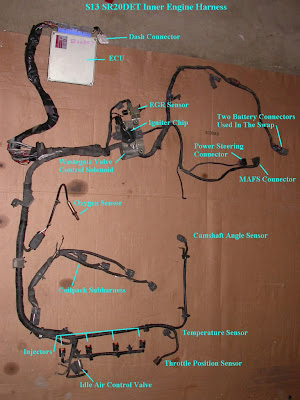Throwing Codes
But the good old fashion non fancy way is Morse code.
You can accomplish this task of pulling a code from your ecu by setting it into diagnostic mode by turning the adjustment screw on the back completely clockwise until it stops, then counter clockwise to the other stop (do not force it past where it stops, you don’t need tree chopping strength for this.) Here is a video demonstrating my results.
Pretty simple right, so lets review what happens.
Once you’re in diagnostic mode the ECU light/CEL Light (depending on your model) will flash a series of blips, to best describe this I will just quote the ECU Fault Codes info from 240sxmotoring.com, normally I would link you there. But in my travels for knowledge concerning these cars, if they go out of business or are bought out, etc.
This information is lost in limbo. So best to spread it in my opinion. Anyway the code’s and how to read them as follows.
Long Flash - 0.6 seconds on (the first digit)
Short Flash - 0.3 seconds on (the second digit)
Long Gap - 2.1 seconds off (used between codes)
Short Gap - 0.9 seconds off (used between digits)
There are two digits in each code. Count the long flashes, then the short flashes (only count how many times the light is ON) and you’ll have a 2 digit code. These codes are covered in the service manual.
Code Meaning
11 - Camshaft Position Sensor
12 - Air Flow Meter
13 - Coolant Temperature Sensor
14 - Vehicle Speed Sensor
21 - Ignition Signal
25 - IACV - AAC Valve
26 - Boost Pressure Sensor
31 - ECM Fault
32 - Exhaust Gas Recirculation System
33 - Front EGO Sensor (O2-1 Sensor)
34 - Knock Sensor
35 - EGR Temperature Sensor
36 - EGR BPT Valve
37 - Closed Loop System
41 - Intake Air Temperature Sensor
43 - Throttle Position Sensor
54 - Signal from Auto Transmission
55 - Other Malfunction. CONSULT Terminal Required
63 - Cylinder 6 Misfire (?)
64 - Cylinder 5 Misfire (?)
65 - Cylinder 4 Misfire
66 - Cylinder 3 Misfire
67 - Cylinder 2 Misfire
68 - Cylinder 1 Misfire
71 - Random Misfire
72 - TW Catalyst System
76 - Fuel Injection System
77 - Rear EGO Sensor (O2-2)
82 - Crank Position Sensor
84 - Automatic Transmission Diagnostic Comms Line
95 - Crank Position Cog
98 - Coolant Temperature Sensor
103 - Park/Neutral Switch
105 - EGR Solenoid
111 - Inhibitor Switch
112 - Automatic Transmission Speed Sensor
113 - Automatic Transmission 1st Signal
114 - Automatic Transmission 2nd Signal
115 - Automatic Transmission 3rd Signal
116 - Automatic Transmission 4th Signal
118 - Automatic Transmission Shift Solenoid Valve A
121 - Automatic Transmission Shift Solenoid Valve B
123 - Automatic Transmission Overrun Clutch Solenoid Valve
124 - Automatic Transmission TOR Conv Solenoid Valve
125 - Automatic Transmission Line Pressure Solenoid
126 - Automatic Transmission Throttle Position Sensor
127 - Automatic Transmission Engine Speed Signal
128 - Automatic Transmission Fluid Temperature Sensor
So with that information I am throwing codes: 12 - Mass Air Flow Sensor, 13 - Coolant Temp Sensor, and 34 - Knock Sensor.
In my next update touching upon this subject, I will document basically how I am going to tackle these items.
12, and 13, both seem like bad sensors or just bad wiring on my part.
34 - knock sensor and I have like a bad history, every motor I have owned even back to my Honda roots have been plagued by the godamned knock sensor, let alone I hate these things will all of my heart and being. It’s the most USELESS thing ever on your motor, for instance I have solid polyurethane motor mounts on this engine, which cause a SHITLOAD of vibration, which obviously the knock sensor can possibly confuse with engine knock.
And then puts your car in limp mode, and so I am just going to eliminate the knock sensor and put an ohm resistor in it’s place and call it a day. Don’t consider my experience to be the end all sermon, if this thing wasn’t 100 dollars to replace, and something you’re guaranteed to reap the benefits of changing to get your car running ship shape. I would document how to change your knock sensor, and all would be great…
But seriously in my experience, I spent 124 dollars on a BRAND NEW knock sensor, put it on the motor, torqued it to spec, and bam.
Code 34, all of the wiring checked out. All voltages were showing the knock sensor was working properly, it just decided my engine was knocking. Which it isn’t, stock boost, stock turbo. And quite frankly I am going to get this car on the road in 2009, the fuck if it will spend another year or month in my garage.
I’ll make sure to keep you kids posted.
Editors note: If you want to try troubleshooting these codes yourself then congratulations, you have earned my respect. To help you along if you have downloaded the sr20det FSM from various places on the net (has a yellow jun 240sx as it’s front page) if you head on to PDF page 179 it will list where in the EC section of the manual you will find the troubleshooting steps for the codes you pulled.
For instance.
ECU Code 12 = Diagnosis Procedure 24 which is located in EC113 (PDF PAGES 249-251)
ECU Code 13 = Diagnosis Procedure 25 which is located in EC116 (PDF PAGES 252-255)
ECU Code 34 = Diagnosis Procedure 28 which is located in EC132 (PDF PAGES 268-270)
Also Just an FYI that FSM is for an S14 Sr20det, the wiring is essentially the same, but the ECU pinouts I assure you are different for other sr20det models. In my case, an s13 redtop. Keep that in mind when tracing wires…
W.E.


